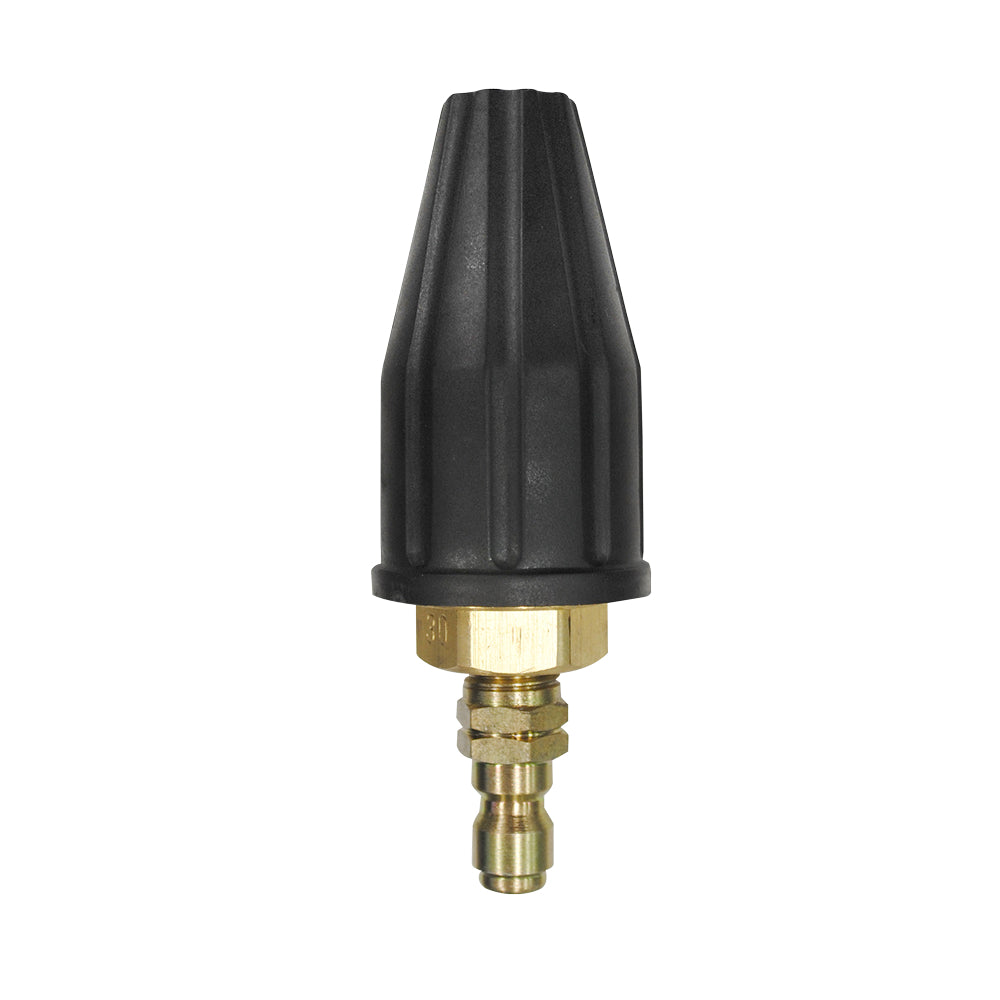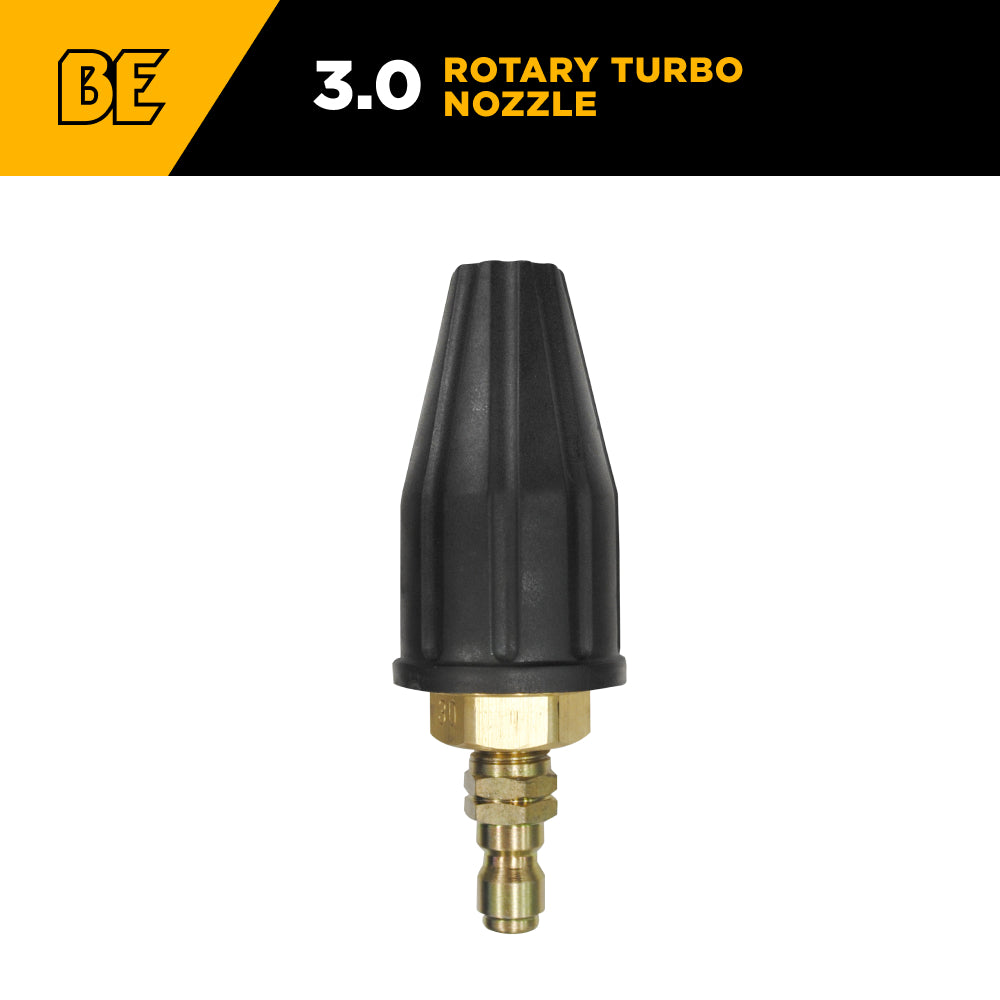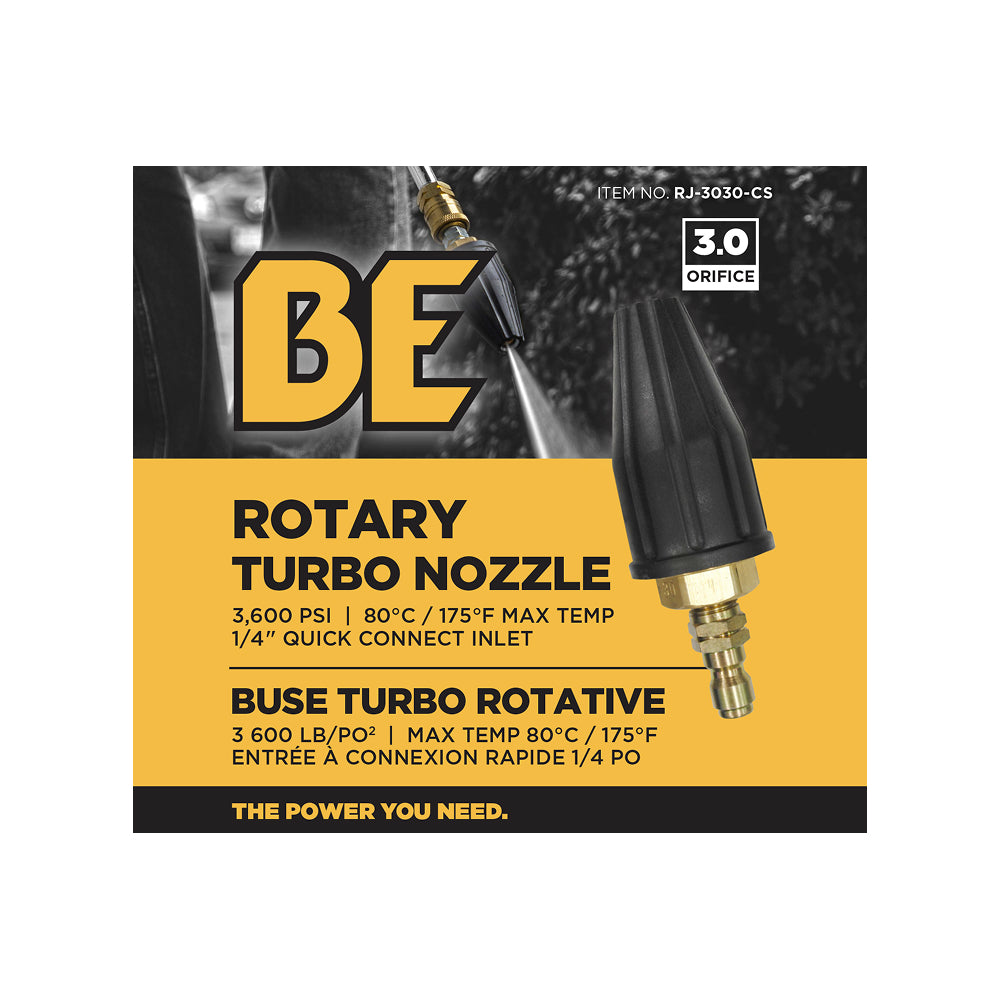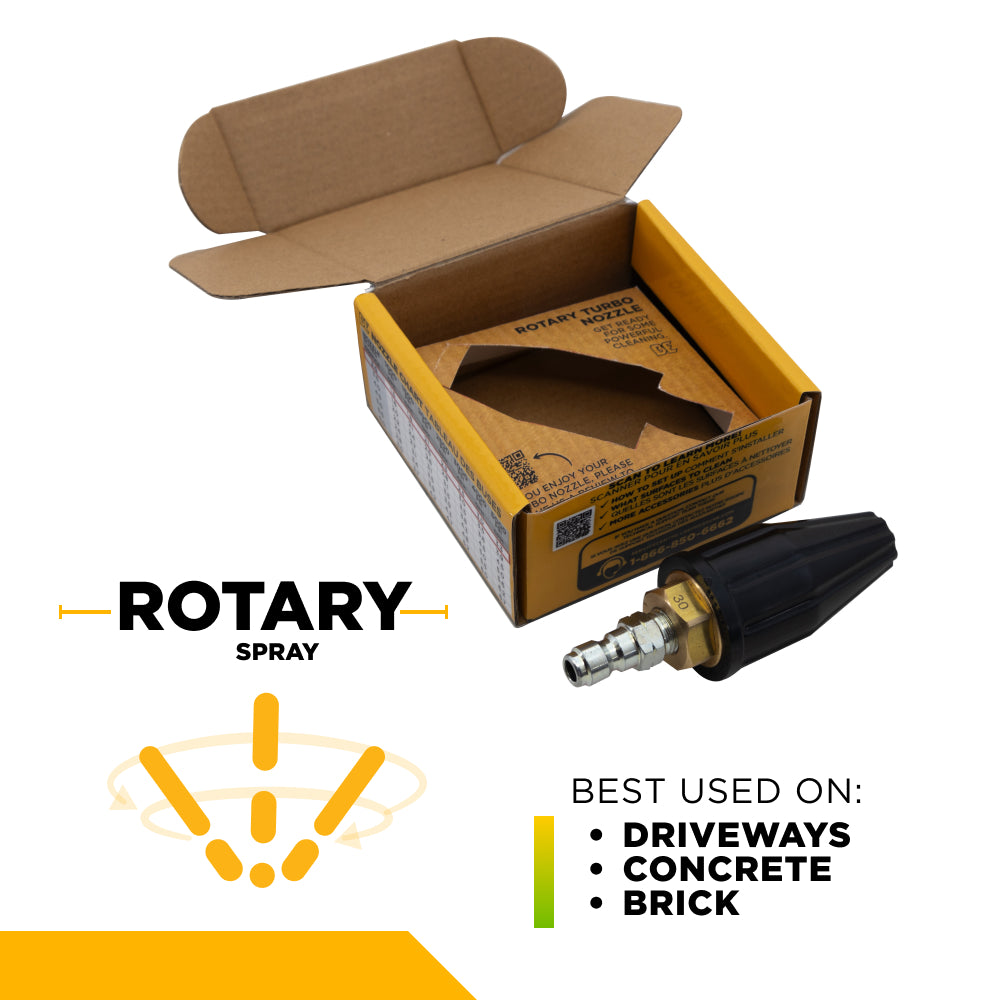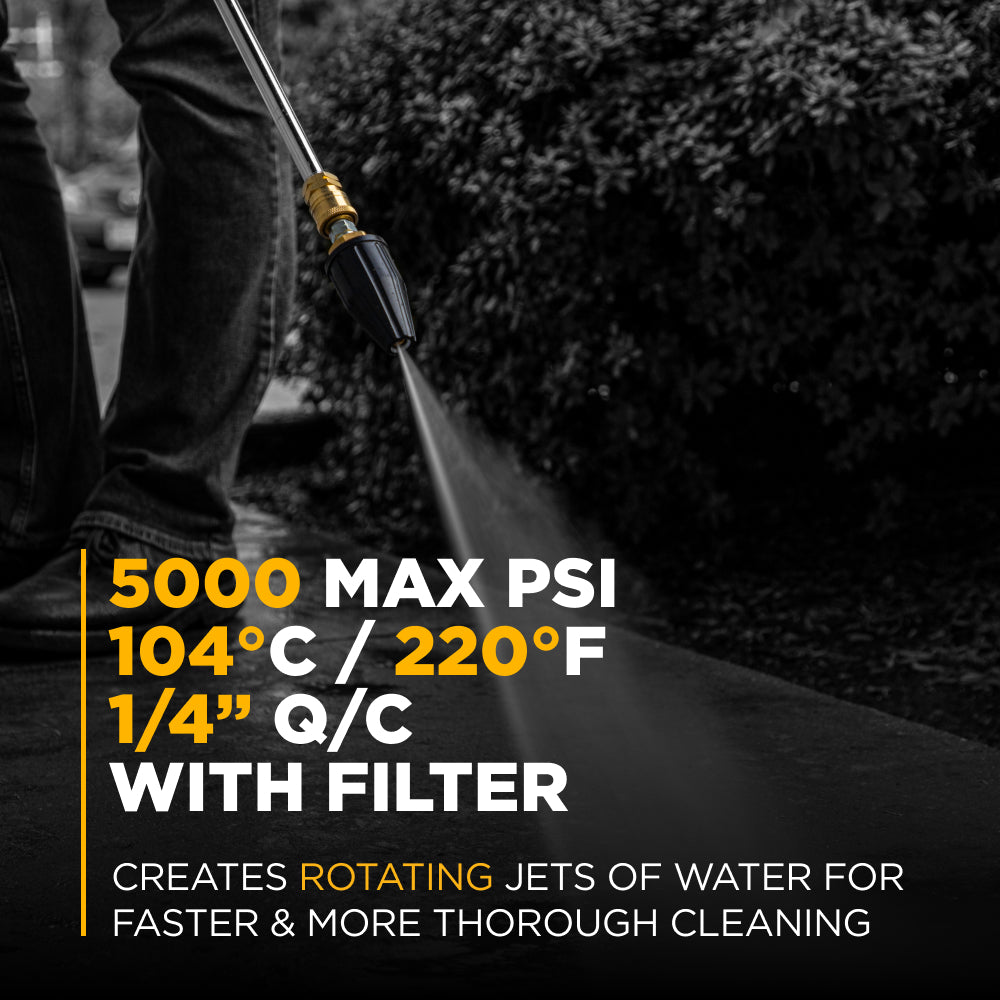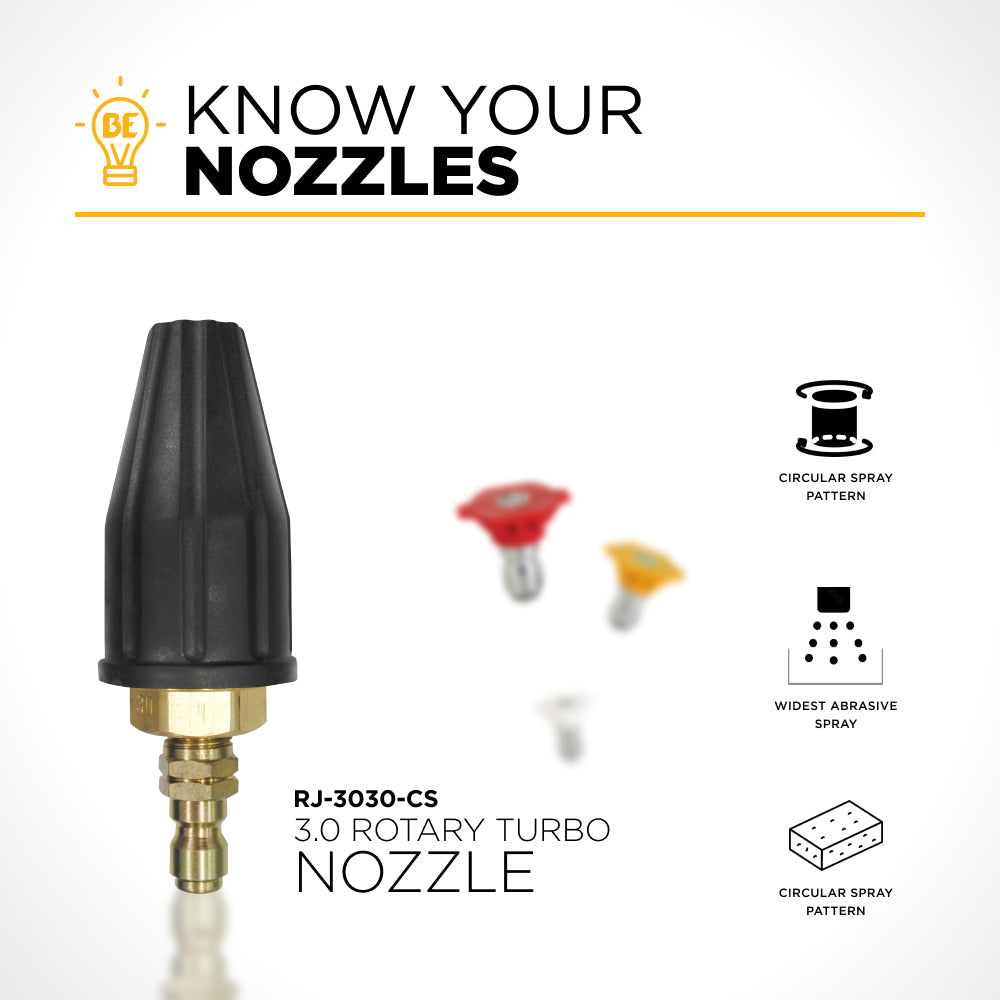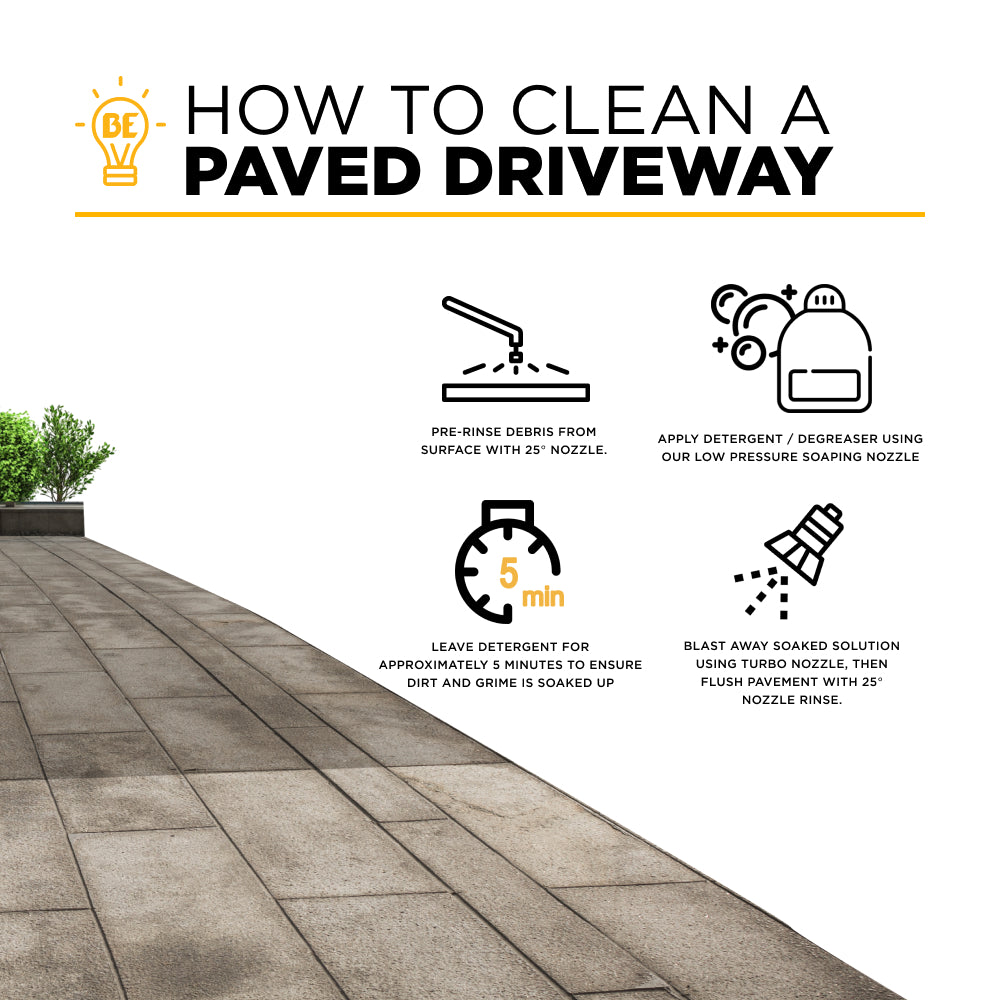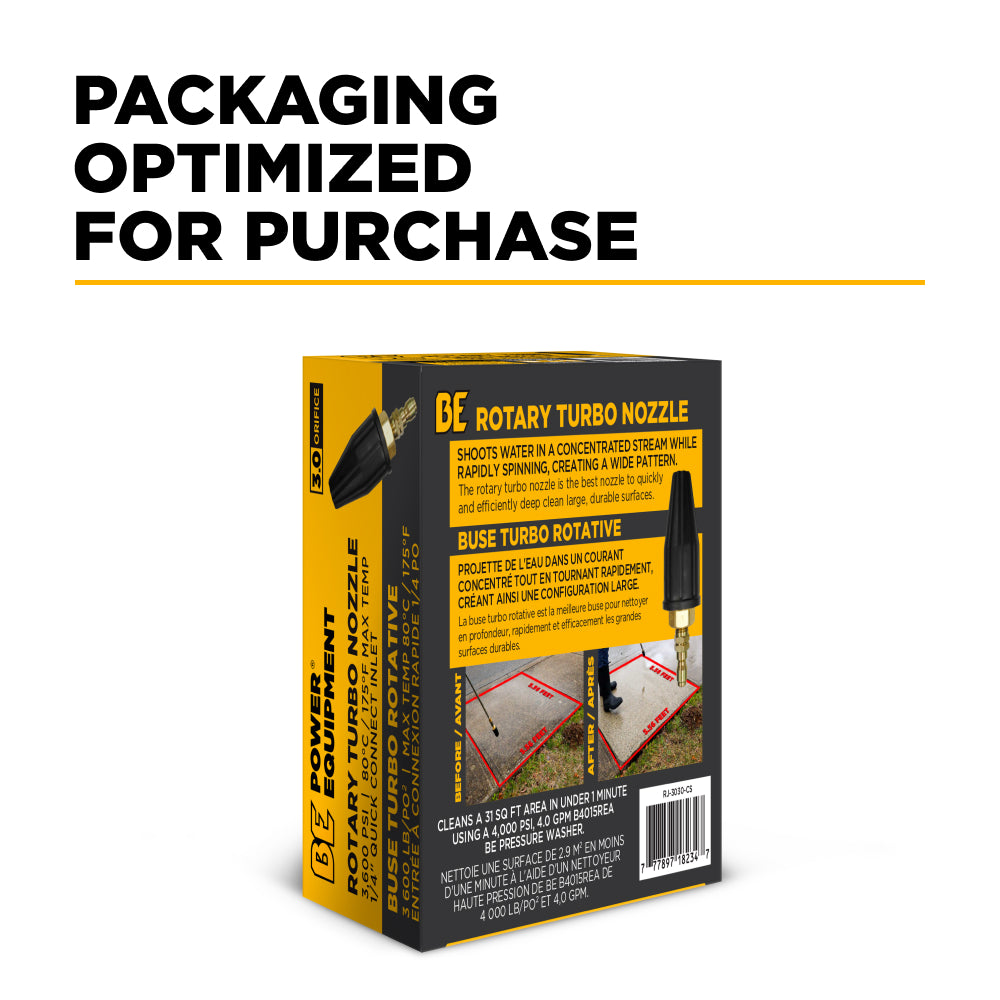PRODUCT
DESCRIPTION
Power Meets Precision – For Maximum Cleaning Impact
Take your pressure washer to the next level with the Rotary Turbo Nozzle 3.0—a high-performance cleaning attachment built to deliver concentrated, high-impact power for tough surface cleaning. Whether you’re restoring weathered concrete, removing embedded grime from sidewalks, or deep-cleaning driveways, this turbo nozzle unleashes the force you need to get the job done—faster, cleaner, and more effectively than standard nozzles.
The turbocharger can provide an increase of 6 to 8 pounds per square inch (psi) in water pressure, significantly boosting cleaning power and efficiency.
Engineered with a 3.0 orifice size, this rotating nozzle is ideal for use with gas-powered pressure washers delivering up to 3,600 PSI and flow rates between 2.5 and 3.5 GPM. It features an ultra-durable ceramic internal rotor, a hardened spray tip, and a 1/4” quick connect inlet for seamless, tool-free attachment to most pressure washer wands. It’s also rated for temperatures up to 80°C (175°F), making it suitable for use with hot or cold water.
For heavy-duty outdoor cleaning jobs, the Rotary Turbo Nozzle 3.0 offers unmatched power and speed—saving time and delivering professional results with every pass.
Key Features
-
3.0 Orifice Size – Calibrated for mid- to high-output pressure washers delivering 2.5–3.5 GPM.
-
Max Pressure Rating: 3,600 PSI – Ideal for cleaning concrete, brick, masonry, and other hard surfaces.
-
Max Water Temperature: 80°C / 175°F – Handles both cold and hot water systems for extra cleaning power.
-
High-Performance Ceramic Rotor – Durable internal components designed for extended life under high-pressure conditions.
-
1/4” Quick Connect Inlet – Universally compatible with most pressure washer spray wands and lances.
-
Rotating Jet Stream – Combines the force of a 0° nozzle with the coverage of a wide spray pattern.
-
Affordable Price – Customers appreciate the good price of the Rotary Turbo Nozzle 3.0, noting its value compared to other nozzles and the satisfaction of receiving multiple nozzles for a great price.
How It Works
The Rotary Turbo Nozzle 3.0 uses a high-pressure jet that spins rapidly in a conical pattern, creating a powerful scrubbing action that penetrates deeply into porous surfaces. The result is a cleaning path that’s:
-
Faster than standard fan nozzles
-
More aggressive on tough stains, grease, and debris
-
More efficient, reducing water and time usage
The rotating motion reduces streaking and spreads the pressure impact across a broader area, which makes it perfect for large, heavily soiled surfaces that would take far longer with traditional nozzles.
Ideal Applications
This turbo nozzle is built for high-impact, ground-level cleaning where power and speed are essential. Perfect for:
-
Driveways
-
Sidewalks
-
Patios and pavers
-
Brick and stone walls
-
Parking lots and loading docks
-
Construction equipment and heavy machinery
-
Removing paint and graffiti from surfaces
Whether you’re a contractor preparing concrete for sealing or a homeowner maintaining hardscaped areas, this nozzle saves time while improving results.
Not Recommended for Soft Materials
Because of its high-impact, concentrated cleaning power, the Rotary Turbo Nozzle 3.0 is not recommended for soft surfaces such as:
-
Wood decks
-
Painted surfaces
-
Vinyl siding
-
Vehicle exteriors
-
Outdoor furniture
Using it on softer materials can cause etching, gouging, or surface damage. Always test on a small area and avoid using on anything that can't handle high pressure.
Safety Precautions
When using pressure washers, especially with turbo nozzles, safety precautions are paramount. The high pressure, which can reach up to 4350 PSI, and the rotating design of turbo nozzles demand careful handling to avoid accidents. Users should always wear protective gear, including gloves, safety glasses, and a mask, to protect themselves from the powerful jet of water and potential debris. Additionally, ensuring the surface to be cleaned is clear of obstacles and fragile items is crucial. It’s also important to follow the manufacturer’s guidelines for the maximum pressure and temperature (up to 185° F for some models) the nozzle can handle to prevent damage and ensure longevity.
Best Practices for Use
To get the most from your turbo nozzle—and ensure safe, effective cleaning—follow these usage tips:
-
Start at a distance – Begin spraying 3 to 4 feet from the surface and move closer slowly. This helps prevent damage and gives you more control.
-
Point the spray gun downward before pulling the trigger. This correctly seats the internal ceramic rotor and prevents internal wear or misalignment.
-
Avoid angling the spray too steeply, which may reduce the effectiveness of the rotary pattern or cause bouncing.
-
Do not use on delicate or heat-sensitive materials, as the force and temperature tolerance are optimized for hard surfaces.
By using the nozzle properly, you’ll maximize both performance and longevity.
Quick Connect = Quick Setup
With a universal 1/4" quick connect plug, this nozzle snaps into your pressure washer wand in seconds. No tools. No adapters. No frustration.
-
Compatible with most major pressure washer brands (e.g., BE, Simpson, DeWalt, Generac, Ryobi, and more)
-
Seamless integration with extension wands and spray lances
-
Ideal for swapping between other QC nozzles or foam cannons during multi-stage jobs
If your pressure washer wand has a quick-connect tip, you're ready to clean.
Built to Last
This turbo nozzle is engineered for longevity, even under harsh conditions. Its rugged outer housing protects the precision ceramic rotor, which is designed to rotate at ultra-high speeds without wearing down prematurely. Additional durability features include:
-
Reinforced polymer or brass casing to withstand impact
-
Sealed internal design to prevent debris from interfering with operation
-
Resistant to high heat and chemicals for commercial-grade usage
Regular rinsing after use and proper storage will help extend the life of the nozzle even further.
Maintenance and Repair
To maintain the effectiveness and extend the lifespan of turbo nozzles, regular maintenance is essential. This includes checking for blockages, cleaning the nozzle after each use, and storing it in a dry place. For repairs, it’s crucial to refer to the manufacturer’s instructions, as improper repair can lead to reduced performance or complete failure of the nozzle. In cases where the nozzle is damaged beyond repair, replacing it with a high-quality alternative is the best course of action. Maintenance not only saves money by prolonging the nozzle’s life but also ensures consistent cleaning performance, making it a worthwhile investment of time and effort.
Specifications Summary
-
Nozzle Orifice Size: 3.0
-
Max Pressure: 3,600 PSI
-
Max Flow Rate: ~2.5–3.5 GPM (varies by washer)
-
Max Temperature: 80°C / 175°F
-
Connection: 1/4" quick-connect plug
-
Spray Pattern: Rotating 0° jet in a conical motion
-
Material: Ceramic internal rotor; durable outer shell
-
Weight: Lightweight for extended use without fatigue
-
Compatibility: Gas-powered pressure washers and heavy-duty electric units with appropriate flow/PSI
Environmental Benefits
The use of turbo nozzles with pressure washers offers several environmental benefits. By providing a more efficient cleaning method, these nozzles help reduce the amount of water and cleaning agents needed, thus minimizing the environmental impact. For example, in graffiti removal and cleaning concrete, turbo nozzles can effectively remove dirt and grime with less water, reducing runoff and the potential for polluting nearby water bodies. Furthermore, the ability to clean surfaces more effectively means less frequent cleaning is required, further reducing water and chemical usage. This efficiency also translates to energy savings, as less time and power are needed for cleaning tasks.
What Makes Turbo Nozzles a Game-Changer?
Turbo nozzles are the hidden weapon in every professional's pressure washer arsenal. They combine the focused intensity of a 0° tip with the coverage of a wide-angle nozzle, allowing you to:
-
Clean twice as fast as traditional tips
-
Conserve water and fuel
-
Reduce manual scrubbing and repeat passes
-
Deliver uniform cleaning patterns
The Rotary Turbo Nozzle 3.0 does all of this with speed, power, and convenience in a single, compact attachment.
The Rotary Turbo Nozzle 3.0 is designed for users who demand more from their pressure washer—more power, more precision, and more productivity. With its aggressive rotary action, durable ceramic internals, and quick-connect convenience, this nozzle is the ultimate tool for blasting through the toughest grime on the hardest surfaces.
Power up. Clean faster. Work smarter. Add the Rotary Turbo Nozzle 3.0 to your arsenal today and experience the next level of pressure washing performance.
Turbo nozzles are a powerful tool in the arsenal of pressure washer accessories, offering unparalleled cleaning efficiency and effectiveness. With their ability to remove tough grime and dirt from various surfaces, including concrete, sidewalks, and even boats, they are an indispensable asset for both residential and industrial cleaning tasks.
By understanding the safety precautions, maintenance requirements, and environmental benefits of turbo nozzles, users can maximize their potential while minimizing risks and environmental impact.
As technology continues to evolve, it’s exciting to consider how future innovations in turbo nozzle design will further enhance cleaning capabilities, potentially leading to more efficient, cost-effective, and environmentally friendly cleaning solutions. Whether for graffiti removal, cleaning algae and moss from surfaces, or simply keeping sidewalks free of gum and dirt, turbo nozzles are set to remain a vital component of modern cleaning practices.
Frequently Asked Questions about Pressure Washers
How to store a pressure washer?
To ensure the durability of your heavy duty pressure washer:
- Empty the gas tank to prevent fuel from degrading or clogging the engine.
- Empty the pump and hoses of any remaining water.
- Perform necessary maintenance before storage.
- Store in a dry area.
- Cover.
What is a pressure washer?
A power washer is a cleaning machine that uses a gasoline engine to power a high pressure water pump and nozzle. It’s used to clean driveways, decks, vehicles, outdoor furniture and more by spraying water at high PSI to remove dirt, grime, mold and other debris.Many models also come with a detergent tank for added cleaning power.
How does a power washer work?
A power washer works by drawing water from a connected hose and pumping it through a high pressure nozzle. The gas engine powers the pump which pressurizes the water and then expels it through the nozzle at high speed to clean the surface. The water pressure is measured in PSI (pounds per square inch) and the flow rate is measured in GPM (gallons per minute).Many models also feature adjustable water pressure settings to cater to different cleaning needs. BE makes pressure washing easy with models available for light jobs and heavy duty commercial cleaning projects.
Gas vs Electric power washers?
The main difference is that a gas pressure washer, known for its cleaning power, is powered by a gasoline engine, making it more powerful and portable, while an electric pressure washer is powered by electricity and is generally quieter and lighter.
Gas pressure washers are for heavy duty and large areas due to their durability, whereas electric pressure washers are for smaller jobs.
Your BE electric pressure washer is perfect for smaller jobs and built for portability, and we offer a wide range of electric models. Included with our electric models is a long extension cord for use anywhere around your house.
What to consider?
When choosing a gas pressure washer consider:
- Pressure (PSI): More PSI means more cleaning power but also more potential for damaging delicate surfaces.
- Flow Rate (GPM): More GPM means faster cleaning as more water is dispensed.
- Engine Power: Bigger engines mean more durability and power.
- Portability: Weight, handle design and wheel size for easier to move.
- Nozzles: Multiple spray nozzles to adjust the spray pattern for different tasks.
- Adjustable Nozzle: Allows for fine-tuning the spray intensity and pattern for various cleaning needs.
How much pressure do I need for?
The required pressure (PSI) and cleaning power depend on the surface you’re cleaning:
- Light duty (car washing, outdoor furniture): 1,300-1,800 PSI.
- Medium duty (patios, fences, decks): 2,000-3,000 PSI.
- Heavy duty (driveways, brick walls, large equipment): 3,000+ PSI.
Many pressure washers come with adjustable pressure settings to handle different cleaning tasks effectively.
Can a pressure washing damage surfaces?
Yes, a power washer can damage surfaces if used incorrectly. High pressure water can strip paint, dent soft surfaces or even cause structural damage if the pressure is too high or the nozzle is held too close to the surface. Always use the right PSI for the material you’re cleaning and keep a safe distance from delicate surfaces.
To prevent damage, consider using a model with adjustable pressure settings.
How to maintain your pressure washer?
To ensure the durability and smooth operation of a pressure washer:
- Change the oil as per manufacturer’s instructions.
- Clean or replace the air filter to ensure good airflow.
- Inspect and clean the nozzle regularly to prevent clogs.
- Drain the gas tank if you’re storing the washer for a long time.
- Check the hoses for leaks or damage and replace them if needed.
- Follow regular maintenance requirements to keep the washer in optimal condition.
Can I use a pressure washer in cold weather and low water temperature?
You can use a pressure washer in cold weather but it’s more difficult. The water flow rate in the hoses and pump can freeze and damage the equipment. If you plan to use your pressure washer in cold temperatures make sure to winterize it and store it in a warm area when not in use. You can also use anti-freeze solutions for pressure washers.
Some models are designed to use hot water, which can be particularly effective for cleaning in cold weather.
Do I need any accessories?
Common accessories for power washers:
- Different nozzles (0°, 15°, 25°, 40°, and soap nozzle) to adjust spray patterns.
- Extension wands for hard to reach areas.
- Surface cleaners for large flat areas like driveways and decks.
- Hose reels to store hoses neatly and prevent tangling.
- Foam cannon or detergent bottles for soap or cleaning solutions.
- Detergents for cleaning a wide variety of surfaces.








